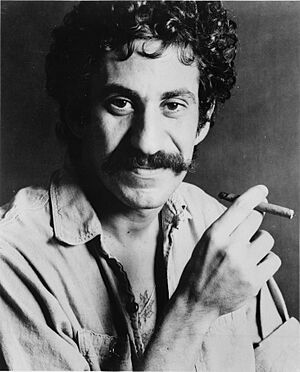Jim Croce facts for kids
Quick facts for kids
Jim Croce
|
|
|---|---|

Croce photographed by his wife Ingrid in 1972
|
|
| Background information | |
| Birth name | James Joseph Croce |
| Born | January 10, 1943 Philadelphia, Pennsylvania, U.S. |
| Died | September 20, 1973 (aged 30) Natchitoches, Louisiana, U.S. |
| Genres | |
| Occupations |
|
| Instruments |
|
| Years active | 1964–1973 |
| Labels | |
|
Pennsylvania Historical Marker
|
|
| Official name | James Joseph "Jim" Croce (1943–1973) |
| Type | Roadside |
| Designated | March 30, 2022 |
James Joseph Croce (pronounced KROH-chee; born January 10, 1943 – died September 20, 1973) was a popular American folk and rock singer-songwriter. He released five studio albums and many singles between 1966 and 1973. During these years, Jim worked many different jobs to pay his bills. He still found time to write songs, record music, and perform concerts.
Jim Croce's music career really took off in the early 1970s. This was after he started working with songwriter and guitarist Maury Muehleisen. His big break came in 1972 with his third album, You Don't Mess Around with Jim. This album had hit songs like "Time in a Bottle", which became a No. 1 hit after he passed away. His next album, Life and Times, included "Bad, Bad Leroy Brown". This was his only No. 1 hit song while he was alive.
Jim Croce died in a plane crash on September 20, 1973. This was at the peak of his fame. His music continued to be popular throughout the 1970s. His wife, Ingrid, who was also a songwriter, kept writing music. Their son, A. J. Croce, later became a singer-songwriter in the 1990s.
Contents
Early Life and School
Jim Croce was born on January 10, 1943, in South Philadelphia, Pennsylvania. His parents, James Albert Croce and Flora Mary Croce, were Italian Americans. Their families had moved to the U.S. from Italy.
Jim grew up in Upper Darby Township, near Philadelphia. He went to Upper Darby High School and graduated in 1960. After that, he spent a year at Malvern Preparatory School. Then he went to Villanova University. There, he studied psychology and also learned German. He was part of the Villanova Singers and another group called The Villanova Spires. When The Spires performed outside of school, they were known as The Coventry Lads. Jim also worked as a student DJ at the radio station WKVU. He graduated from Villanova in 1965.
Jim Croce's Music Career
Starting Out
Jim Croce didn't get serious about music until he was at Villanova. He became a leader in the Villanova Singers. He also formed bands and played at parties, coffeehouses, and colleges around Philadelphia. He would play "anything that the people wanted to hear," like blues, rock, and folk music. Jim's band was even chosen for a student exchange trip to Africa, the Middle East, and Yugoslavia. He said, "We just ate what the people ate, lived in the woods, and played our songs." He noted that even though people didn't speak English, they understood his music.
On November 29, 1963, Jim met his future wife, Ingrid Jacobson. They met at a music event in Philadelphia.
In 1966, Jim released his first album, Facets. He made 500 copies. His parents gave him $500 as a wedding gift, but they wanted him to use it to make an album. They hoped that if the album didn't do well, he would stop music and get a more traditional job. But the album was a success, and all 500 copies sold!
The Late 1960s
Jim married Ingrid Jacobson in 1966. He also changed his religion from Catholicism to Judaism, as his wife was Jewish. They had a traditional Jewish wedding. That same year, Jim joined the Army National Guard in New Jersey. He did this to avoid being sent to the Vietnam War. He served for four months, starting just one week after his honeymoon.
From the mid-1960s to the early 1970s, Jim and Ingrid performed as a musical duo. At first, they sang songs by other artists. But soon, they started writing their own music. Jim got his first regular job playing music at a bar and steakhouse called the Riddle Paddock in Lima, Pennsylvania. He played many types of music there, including blues, country, rock and roll, and folk.
In 1968, a record producer named Tommy West encouraged the Croces to move to New York City. They lived in the Bronx and recorded their first album with Capitol Records. This album was called Jim & Ingrid Croce. Ingrid said they drove over 300,000 miles in two years. They played in small clubs and colleges to promote their album.
Jim and Ingrid became tired of the music business and New York City. They sold almost everything they owned to pay rent and moved back to the countryside in Pennsylvania. They settled on an old farm in Lyndell. Jim played music for $25 a night. To make more money, he took other jobs. He worked as a truck driver, did construction work, and taught guitar lessons. He kept writing songs, often about the people he met at local bars and truck stops. Some of these songs were "Big Wheel" and "Workin' at the Car Wash Blues."
The 1970s and Breakthrough
The Croces eventually moved back to Philadelphia. Jim decided he wanted to be "serious" about his music career. He had worked construction and welding before. He said he would rather do other things than get burned. He even got a job at a radio station, WHAT, where he wrote commercials.
In 1970, Jim met Maury Muehleisen. Maury was a talented pianist, guitarist, and singer-songwriter. At first, Jim played guitar for Maury. But soon, their roles switched. Maury started adding lead guitar to Jim's songs.
When his wife Ingrid became pregnant, Jim became even more determined to make music his full-time job. He sent a tape of his new songs to a friend in New York City, hoping to get a record deal. Their son, Adrian James (A. J.), was born in September 1971. Ingrid stayed home with A. J. while Jim went on tour to promote his music.
In 1972, Jim signed a contract with ABC Records for three albums. He released two albums that year: You Don't Mess Around with Jim and Life and Times. Songs like "You Don't Mess Around with Jim", "Operator (That's Not the Way It Feels)", and "Time in a Bottle" became popular on the radio. The Croce family moved to San Diego that same year. Jim also started appearing on television shows like American Bandstand and The Tonight Show.
Jim Croce and Maury Muehleisen began touring across the United States. They played in large coffee houses, college campuses, and folk festivals. Even with his growing fame, Jim's money situation was still difficult. The record company had given him money to record, and much of his earnings went to pay back that advance.
In February 1973, Jim and Maury toured Europe. They performed in cities like London, Paris, and Dublin, and received great reviews. Jim also appeared on TV shows like The Midnight Special. His biggest hit song, "Bad, Bad Leroy Brown", reached No. 1 on the American charts in July.
Jim finished recording his next album, I Got a Name, just a week before he died. While on tour, he missed his family very much. He decided he wanted to take a break from music and settle down with Ingrid and A. J. after his Life and Times tour ended. In a letter that arrived after his death, Jim told Ingrid he wanted to quit music. He planned to write short stories and movie scripts instead.
Death
On the night of Thursday, September 20, 1973, Jim Croce and five other people died in a plane crash. This happened during his "Life and Times" tour, which was supposed to have 45 concerts. It was also the day before his new song, "I Got a Name", was released. Their chartered plane, a Beechcraft E18S, crashed into a tree during takeoff from the Natchitoches Regional Airport in Natchitoches, Louisiana. Jim Croce was 30 years old.
The others who died in the crash were pilot Robert N. Elliott, Jim's bandmate Maury Muehleisen, comedian George Stevens, manager Kenneth D. Cortese, and road manager Dennis Rast. An hour before the crash, Jim had finished a concert at Northwestern State University. He was flying to Sherman, Texas for another concert.
An investigation found that the pilot failed to see the tree. This was likely due to his health and fog that made it hard to see. Jim Croce was buried at Haym Salomon Memorial Park in Frazer, Pennsylvania.
Legacy
The album I Got a Name was released on December 1, 1973, after Jim's death. This album included three hit songs: "Workin' at the Car Wash Blues", "I'll Have to Say I Love You in a Song", and the title song. The title song had been used in the movie The Last American Hero a few months earlier. "I'll Have to Say I Love You in a Song" reached No. 9 on the music charts.
The song "Time in a Bottle" was not originally released as a single. But after Jim's death, its lyrics about time and wanting more of it became very meaningful. The song was played a lot on the radio, and people wanted it released as a single. When it was finally released, it became Jim Croce's second and final No. 1 hit. After "Time in a Bottle" was No. 1, the album You Don't Mess Around with Jim also became No. 1 for five weeks.
A collection of his greatest hits, called Photographs & Memories, was released in 1974. Other albums and DVDs of his performances have been released since then. In 1990, Jim Croce was honored and added to the Songwriters Hall of Fame.
The band Queen released a song in 1974 called "Bring Back That Leroy Brown." The title and lyrics of this song refer to Jim Croce's hit song "Bad, Bad Leroy Brown."
In 2012, Jim's wife, Ingrid Croce, wrote a book about him called I Got a Name: The Jim Croce Story.
In 1985, Ingrid Croce opened a restaurant and jazz bar in San Diego. She had joked about this idea with Jim. She owned and managed it until 2013. She opened another restaurant in 2013, which she closed in 2016.
In 2022, a Pennsylvania Historical Marker was placed outside Jim Croce's old farmhouse in Lyndell. This marker honors his life and music.
Discography
- Studio albums
- Facets (1966)
- Jim & Ingrid Croce (1969)
- You Don't Mess Around with Jim (1972)
- Life and Times (1973)
- I Got a Name (1973)
See also
 In Spanish: Jim Croce para niños
In Spanish: Jim Croce para niños


